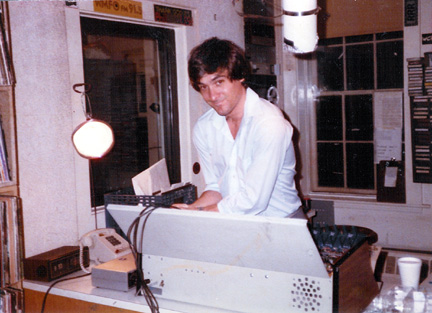
In 1984, I returned to the Boston area after a couple of years postdocing in Zurich. As I've always enjoyed doing radio shows (and had collected some great underground music while living in Europe), I began doing a music program again at WMFO, the Tufts University radio station where I had worked as an undergraduate (several old friends were still there at the time). The station was in a terrible technical state, however. Many things were broken, including various units that I had built myself way back when. The studio was never properly designed, and rather than put in a proper infrastructure, quick patches were done to keep the fragile mess on the air. I started fixing occasional things so I could use them myself - this process was a slippery slope, however, and I soon found myself leading a large crew of volunteers of mixed backgrounds (both from Tufts and from the local community) to do a complete technical overhaul of the station. It could be called a labor of love, or perhaps an obsession - it became all to central too the lives of the two primary players in this (myself and Leigh Shein, who eventually became the Chief of Staff at OPM [the Federal Office of Personnel Management] under the Clinton Administration; Leigh's personnel skills were in evidence even way back then!). It took about two years, but we finished the entire project, completely overhauling and redesigning the entire place. In the process, I designed lots of circuitry for audio and radio studios. In order to keep the station serviceable, I put everything together in a document that could be referenced. It was a total braindump, as I wanted nothing further to do with the station after building it - I could (and did) just point people to this document when issues arose. This strategy was quite successful; the infrastructure that we put in there nearly 20 years ago is still running fine (after not having been there for well over a decade, I dropped by in fall of 2002 when I was on campus to give the Tufts EECS Colloquium on my MIT research - the gear is all still there...).
As the final document that I wrote contains circuits and insights that may be useful for the community at large, I'm posting a .pdf of it here. It contains details on many circuits such as audio distribution amplifiers, telephone drivers, preamplifiers, single-to-differential converters, studio switchers, etc. Much of it is obsolete nowadays, but on the other hand, much of it is still relevant. For posterity, I'm also posting a few old photos below too.
Click here to download the PDF file (36 Meg) - The Complete Technical Guide to WMFO
Photographs of us during the project
An exhausted me debugging the Studio Switcher back in 1985 or so.
Me and Leigh looking at the Switcher.
Me drinking a coffee and relaxing in a gap in the main studio rack where the Otari tape deck eventually went.
Leigh working on a rack.
Photographs of the gear (still in operation in 2003!).
The Stereo Interface - a flexible utility to get audio into and out of the board.
The Master Control Rack, with Studio Switcher, EQ, utility amplifier, oscillator, etc.
The main panel of the Studio Switcher.
One of three Switcher remote panels (showing a patina from 15 years of grime).
The Phone-Doorbell unit and PA/Mixer unit - the two oldest devices in the rig, which I'd originally built in 1977.
Homemade circuit cards and miscellaneous clutter behind the Phone-Doorbell and PA/Mixer Unit - it's amazing that these things still work.


